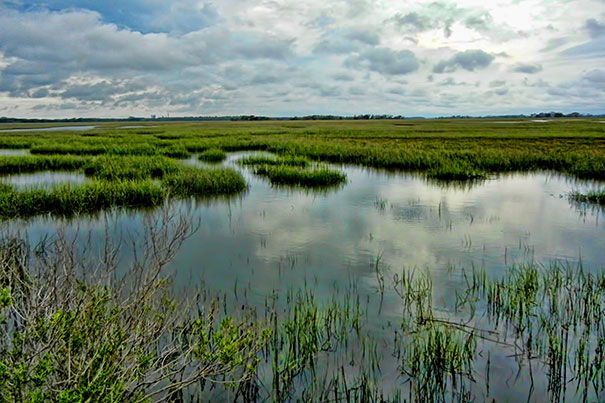
Salt marshes provide a natural barrier of coastal protection along Georgia’s shoreline.
Credit: Wikimedia Commons
Nature as storm defender
Seawalls not only fail often but can promote environmental damage, researcher says
More like this
For years coastal homeowners have tried to beat back Mother Nature with seawalls, imposing structures of wood and/or concrete intended to fend off angry tides and surging storms. But emerging research suggests that in some areas, biological barriers both better protect against erosion and preserve vital ocean habitats.
Not only have seawalls in certain areas been shown repeatedly to fail when tested, but they pose a threat to the delicate ecosystems associated with wetlands and intertidal areas, Rachel Gittman, a postdoctoral research associate at Northeastern University’s Marine Science Center, said during a talk at Radcliffe on Thursday. Instead of absorbing energy generated by wind and waves, seawalls reflect that force back into the water, said Gittman, further eroding the shore and erasing important habitats for fish, crabs, and shore birds.
“You are essentially talking about a little over a 25 percent loss in biodiversity and also around a 35 to 40 percent loss in abundance when you have a seawall instead of a natural shoreline.”
Gittman’s talk was part of the Radcliffe Institute for Advanced Study’s “Next in Science,” a new program that brings together early career scientists to present their research to the Harvard community and the public. The session, which included speakers from the University of Glasgow and the Sea Education Association, was a preview of Radcliffe’s October ocean symposium, “From Sea to Changing Sea,” as well as a series of upcoming ocean-related talks.
Gittman’s graduate research along the North Carolina coast in the aftermath of Hurricane Irene in 2011 suggests that the use of “living shorelines” instead of seawalls “can protect private property from these coastal hazards without compromising the habitats.” (The National Oceanic and Atmospheric Administration defines a living shoreline as one that “uses plants, sand, and limited use of rock to provide shoreline protection and maintain valuable habitat.”)
In an area of North Carolina hardest hit by the hurricane, Gittman observed “75 percent of the bulkheads had some kind of damage,” while other types of shorelines, including living shorelines, were damage-free.
While such living shorelines won’t work everywhere, they are often a viable option, said Gittman, who helped North Carolina residents plant sea grass for their living shorelines as part of her research. “And with the right amount of education and incentives,” she added, “it’s possible we could push private-property owners in the direction of thinking about the long-term sustainability and resilience and ecological function of their shorelines rather than just ‘I want my property to stay exactly the way it is for the next 30 years.’”
Whale chatter amid the clamor
The ocean is a noisy place, explained Ana Širović during her afternoon presentation on whale communication. Natural sea sounds include the songs of marine mammals, as well as the din made by rain, waves, and even the low thunderclap rumble generated by underwater earthquakes. But man also contributes to the clatter, from shipping tankers, oil drills, and commercial and navy sonar.
Carefully discerning and studying the songs of giant blue whales is a main focus of Širović, an assistant researcher in the marine bioacoustics lab at the Scripps Institution of Oceanography in San Diego. Her research, she said, helps shine a light on the distribution, behavior, and population structure of the marine life.
Recent genetic analysis suggests that blue whale populations off Chile differ so greatly from those off Australia that the Chilean whales might be considered a separate subspecies, said Širović. She hopes that a close analysis of the whales’ songs will support those findings. “If we can measure the amount of difference in different songs of different populations, we could also form more refined hypotheses on how likely they are to be different populations.”
Research suggests that just like human language, whale songs are frequently passed on from generation to generation. Humpback whale songs change and evolve, said Širović, citing an example of a whale that arrived off the east coast of Australia singing the western Australian whale song. “Within two seasons, everybody adopted the [eastern] song.
“There clearly is some transmission and exchange between these different populations,” Širović added, “but we don’t really know a whole lot about how that works.”






